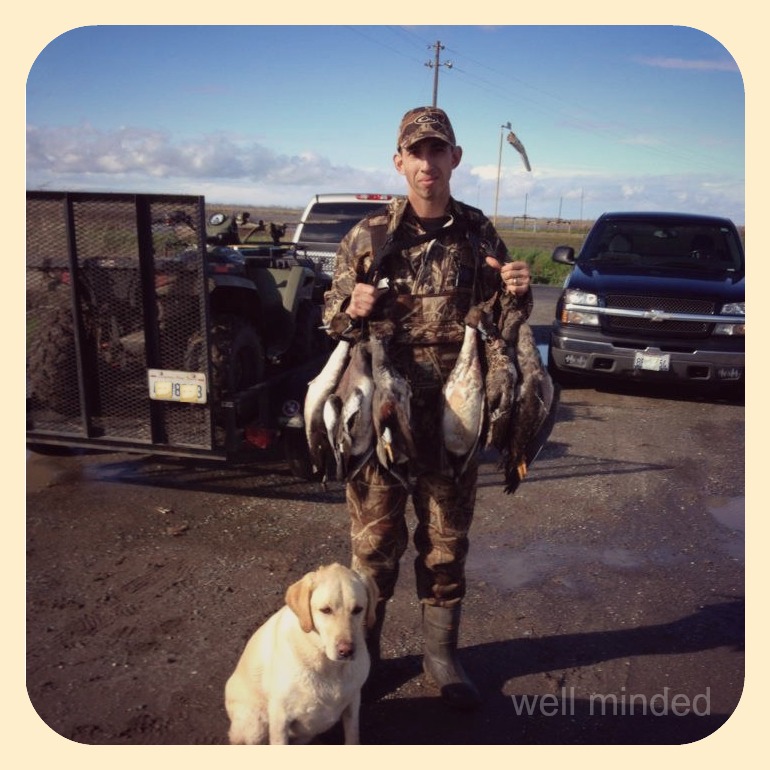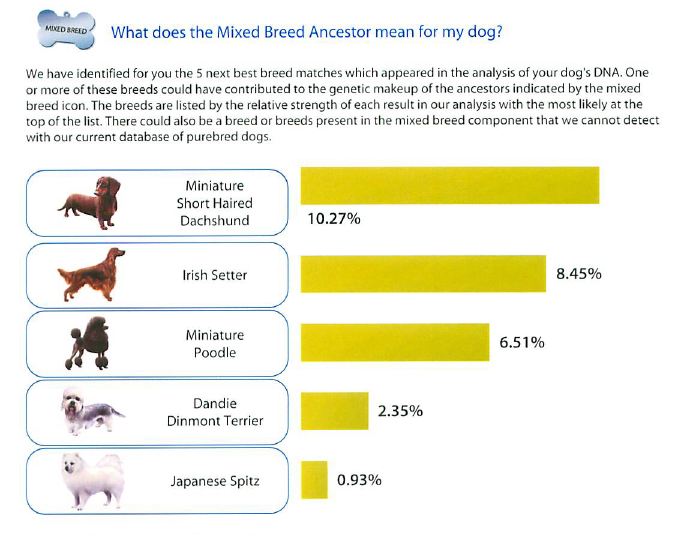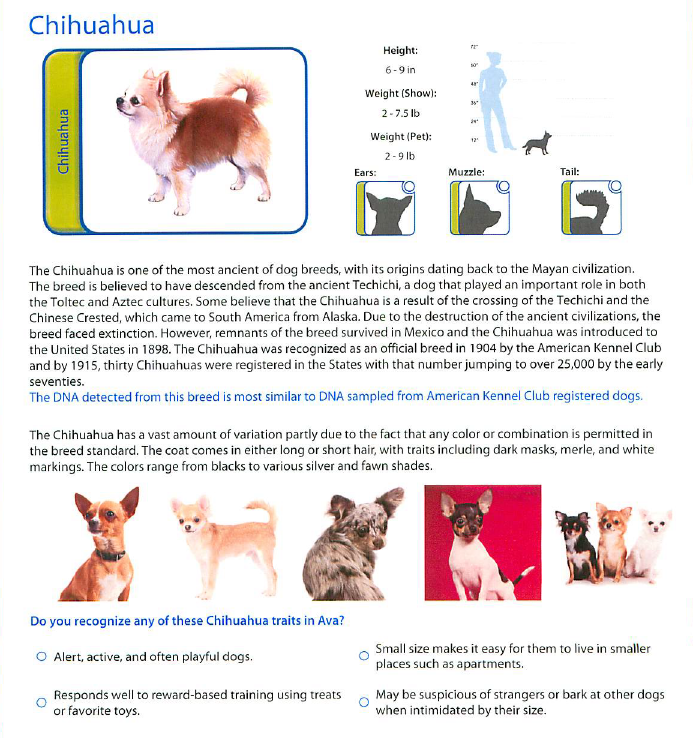debating the hunt with Greg (part 2): the ethical hunter
I've been speaking to my brother-in-law, Greg, about his avid hunting for years, and I've written about it before. Although I'm now aiming at a vegan lifestyle, I've eaten his kills in the past with delight, as long as I didn't have to see their faces. Yes, I was that kind of meat eater. A crispy, tender breast is not nearly as lovable as the duck from which it comes.
That is becoming more difficult for me to swallow. I had a conversation with Greg about the hunter and the hunt. Since Greg most often hunts water fowl and upland game birds, we focused on that.
WM: Greg, I know that you are an "ethical hunter." That will sound like an oxymoron to a lot of our readers.
Greg: Well, first off, let me say that a good ethical hunter does not take game for the sake or thrill of the kill, and they only take what they need or will use. I think that water fowl and upland game birds are delicious–a delicacy–so I always eat what I kill.
WM: So the meat doesn't go to waste for the sake of a studly picture, and you're not hanging them on your wall. How much do the animals suffer?
Greg: Not every shot is a good clean kill. There are times when you might only break a wing or create an injury that renders the bird flightless. When a bird is recovered that is not dead, a quick ring of the neck is usually what is done to kill the bird.
WM: Ugh.
Greg: With that said, practicing good ethical hunting can greatly decrease the amount of crippled birds. A good ethical hunter knows the distance and range that is lethal and will only take shots within that range, which results in more clean kills.
WM: So less suffering?
Greg: Yes, and the use of a well-trained dog greatly increases the amount of game recovered.
WM: So a crippled bird isn't left to suffer in a bush?
Greg: Exactly. There is no doubt that you are killing an animal, and some people will never be able to look past that. For me, it is something I have been able to look past, as a hunter.
WM: You often talk about how hunters benefit the population of animals they kill, as a whole. Will you please explain that?
Greg: Hunters do more for wildlife conservation, preservation, and habitat restoration than any other group. It is the revenue, donations, and volunteer hours from hunters that have attributed to the success of organizations such as Ducks Unlimited and Pheasants Forever, as well as state and federal game regulatory agencies.
WM: So how does this help the animals?
Greg: Simply put, if you were to remove hunters out of the equation, you would see a rapid decline in wildlife populations, habitat, and funding. It is the revenue generated from hunting that allows many of the wildlife organizations to exist. Many manufactures of hunting equipment direct percentages of revenues to support various wildlife organizations. In some instances, 100% of state and federal funding comes from the sale of hunting licenses of species specific tags.
WM: Isn't this all a bit self-serving in the name of conservation? I mean, the greater the population of animals, the more there is to hunt, right?
Greg: We, as hunters, are advocates for the well-being and long term health of the species we hunt. We do not do this with the hopes of killing more animals. It is to ensure the animals' survival and the protection of the habitat needed to support a healthy population.
WM: So there is thought given to the natural balance of things?
Greg: As humans, we have corrupted the natural ecosystem and destroyed millions of acres of habitat through development, farming, and pollution. It is our responsibility as hunters to restore the habitats needed to support healthy populations of wildlife, and it is our role as hunters to keep populations at a level that the available habitat will support. Different states and regions will set game limits accordingly. If it were not for hunters, some species would literally overpopulate and destroy their own habitat and run the risk of spreading diseases that could threaten the long term survival of the species.
WM: So hunters are actually helping maintain a balance between habitat and population.
Greg: Ducks Unlimited explains it well:
Ducks Unlimited is the world's leader in wetlands and waterfowl conservation.
DU got its start in 1837 during the Dust Bowl when North America's drought-plagued waterfowl populations had plunged to unprecedented lows. Determined not to sit idly by as the continents waterfowl dwindled beyond recovery, a small group of sportsmen joined together to form an organization that became known as Ducks Unlimited. Its mission: habitat conservation.
WM: Thank you for speaking about this, Greg.
Greg is able to take what I tend to see simply as an lighthearted, thoughtless slaughtering of innocent animals and raise in me a greater appreciation for the ethical hunter. I may not be able to accept it, but at least I can better understand it.
It does raise other questions for me, however. Though the "ethical hunter" seems to be doing his part to give back, what percentage of hunters are ethical? And if you're not an "ethical hunter," what category do you fall into, and what does that look like?
Do you have any questions for Greg?
Ultra Oil for Pets
I used to think supplements unnecessary. I make sure my family eats healthy, nutritious food, so why should we need anything more? I learned that due to the depletion of minerals in our soil, the foods we thought were so nutrient-rich–and should be–sadly, are not. Even whole, organic, natural foods don't pack quite enough punch. So I put my family on the best supplements I could find with maximum absorption. The whole family takes multivitamin & minerals, calcium, and omega-3s, and us oldsters also take joint supplements so we don't get all crotchety when we try to run around.
But what about N.A.S.H.A., our dog? She just turned eight, yet still acts like a puppy. Would she need to supplement, too? I feed her the highest-quality food. But then, taking what I know into consideration...she'd probably need to get on board with the rest of the family.
I discovered Ultra Oil, a skin and coat supplement, a balanced source of omegas for pets. Ultra Oil is designed to compensate for the deficiencies found in our pets' foods. It is heart-healthy and helps with immunity and overall organ function as well as itchiness and skin dryness.

Although N.A.S.H.A. is healthy overall, she has that wiry fur that easily tangles, and she has seasonal allergies that cause her to lick and chew her paws at various times of the year (like, now), depending on what's in the air and on the ground. Since pets absorb everything they step on through their paws, it's easy to understand why it's common for pets to pay so much negative attention to them.

Tony Klabunde from Ultra Oil describes the supplement:
Ultra Oil gives you everything you need from a fish oil supplement with the omega-rich, low mercury sardine & anchovy, but we don't stop there. We add hempseed oil (nature's most balanced source of omegas) along with flaxseed and grapeseed oil. This allows for the complete profile of healthy fats, including omega 9s, in the right balance to be optimally absorbed. We believe this is why our supplement is so much more effective at healing allergic breakouts, itching, and hot spots that fish oil alone just can't touch. After people see the effectiveness of this balance on even the most serious skin irritations, they keep coming back, but the #1 thing that causes people to originally switch from fish oils is the fact that Ultra Oil doesn't have that stinky odor.
And, it's true! I really stuck my nose in there, and the stuff has no odor whatsoever. N.A.S.H.A. is a super picky eater, so I thought for sure she'd reject her altered regular food when I put the Ultra Oil on it, but I have seen no change in her eating habits whatsoever, so she either likes it or doesn't notice it. Based on her weight, all she needs is one pump per day. Administration instructions are on the bottle, so you'll know how much your pet needs.
After being on Ultra Oil for a month, now, I have noticed a reduction in the amount of time N.A.S.H.A. spends tending to her paws. There is an occasional lick, but, for the most part, the Ultra Oil has alleviated her allergic reactions. Though her fur isn't like that of a mink, and she'll always be prone to dreadlocks, it seems softer to me and tangles less.
I love the fact that Ultra Oil is non GMO and completely human grade. The farmers from which they source their seed oil use sustainable farming practices. So I can feel good about giving it to my pet.
Though we've seen some benefits in N.A.S.H.A., I'd love to see first hand how the stuff works on a dog with extreme allergies and hot spots. Stay tuned for future reviews!
Ultra Oil is available for individual use and wholesale applications.
Disclaimer: I was provided Ultra Oil in exchange for my honest opinion.
doggie dna analysis: Ava's story
I've been taking care of Ava almost every weekday for the past two years. Her family adopted her from a local poodle rescue. Huh? Does this look like a poodle?
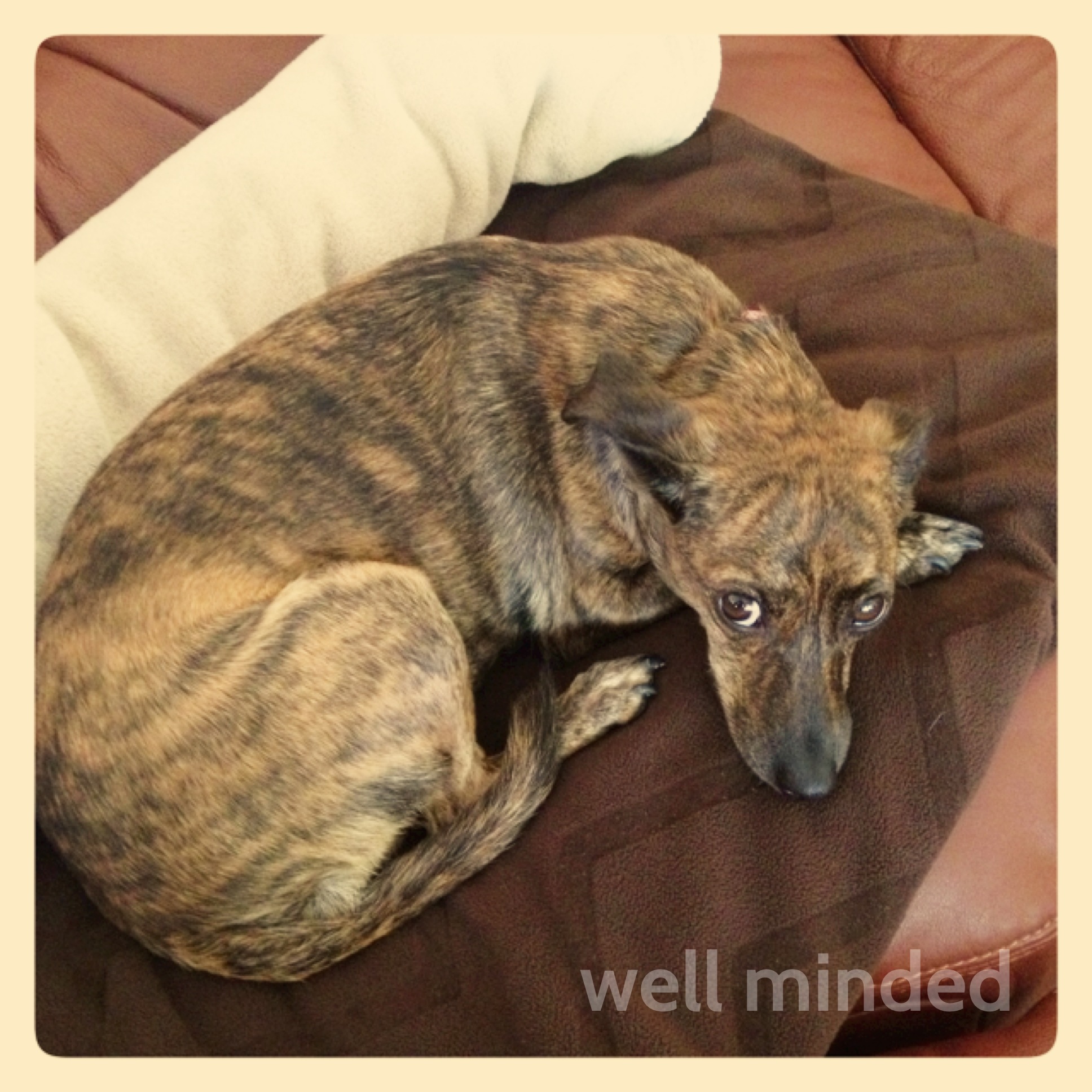
Since Ava's ancestry was a complete mystery, her family decided to have a DNA analysis done. Their veterinarian offered the convenience of doing the blood draw for the test during her regular appointment and sent it to Wisdom Panel for analysis. Though there are less expensive options, Ava's mom, Maura, liked the convenience of doing it right there at the vet. She paid $125.00. Maura explained that there are at-home testing options that use saliva that some people may prefer.
Though DNA testing is not medically necessary, it sure is fun! Ava's family was simply curious of their rescue dog's origins so they decided to proceed with the analysis.
Wisdom Panel's report was nine pages of detailed information about Ava, including "Breed Detection," "Breed Appearance & Behavior," "Appearance, Behavior & History," and "Sharing Your Dog's Story."
Ava's mix was declared to be an "American Eskimo Dog Mix crossed with Yorkshire Terrier/Chihuahua cross." Huh? The only thing I see in her is possible Chihuahua. Good thing the report goes into detail.
The next page went on to detail what "Mixed Breed" means for Ava:
And there we see the poodle in her! It makes me think that maybe I might have a bit of poodle in me, too! It's pretty cool to be able to see in such detail what Ava's background is.
I asked Maura what she thought of the results. She said, "I was surprised that her great grandparents and grandparents could be American Eskimo Dogs. I was not surprised to see Terrier, Chihuahua, or Dachshund in her history."
I would have to agree with Maura. I was pretty shocked to see the American Eskimo Dog make an appearance.
Ava's report went on to explain the Chihuahua, Yorkshire Terrier, and American Eskimo Dog breeds in detail and suggested possible traits of these breeds that her family might see in her.
So how does this all work? Wisdom Panel said,
The process started when you sent a sample to our laboratory, where the DNA was extracted from the cells and examined for the 321 markers that are used in the test. The results for these markers were sent to a computer that evaluated them using a program designed to consider all of the pedigree trees that are possible in the last three generations. The trees considered include a simple pedigree with a single breed (a likely pure-bred dog), two different breeds at the parental level (a first-generation cross), all the way up to a complex tree with eight different great-grandparent breeds allowed.
Our computer used information for over 225 breeds, varieties, and types from our breed database to fill these potential pedigrees. For each of the millions of combinations of ancestry trees built and considered, the computer gave each a score representing how well that selected combination of breeds matched to your dog's data. The pedigree with the overall best score is the one that is shown on the ancestry chart. Only breeds that reached our set confidence threshold for reporting are reported in the ancestry chart.
Maura was really happy that she satisfied her curiosity in having the DNA analysis done. Some may argue "I love my dog. Who cares what she is?" Well, of course we love our dogs no matter what, but knowing what is in their background may give us the opportunity to better care for our pets. And despite even that, it sure is fun!
Report provided by Ava's family.
the sock toe
A cat batting a bottle cap. A pup crunching a plastic water bottle. No matter how much money we spend on the latest and greatest pet toys, often our pets find the most joy in the simple. And your daughter would rather play with the box than the $300 Barbie Dream House that came in it. You know.
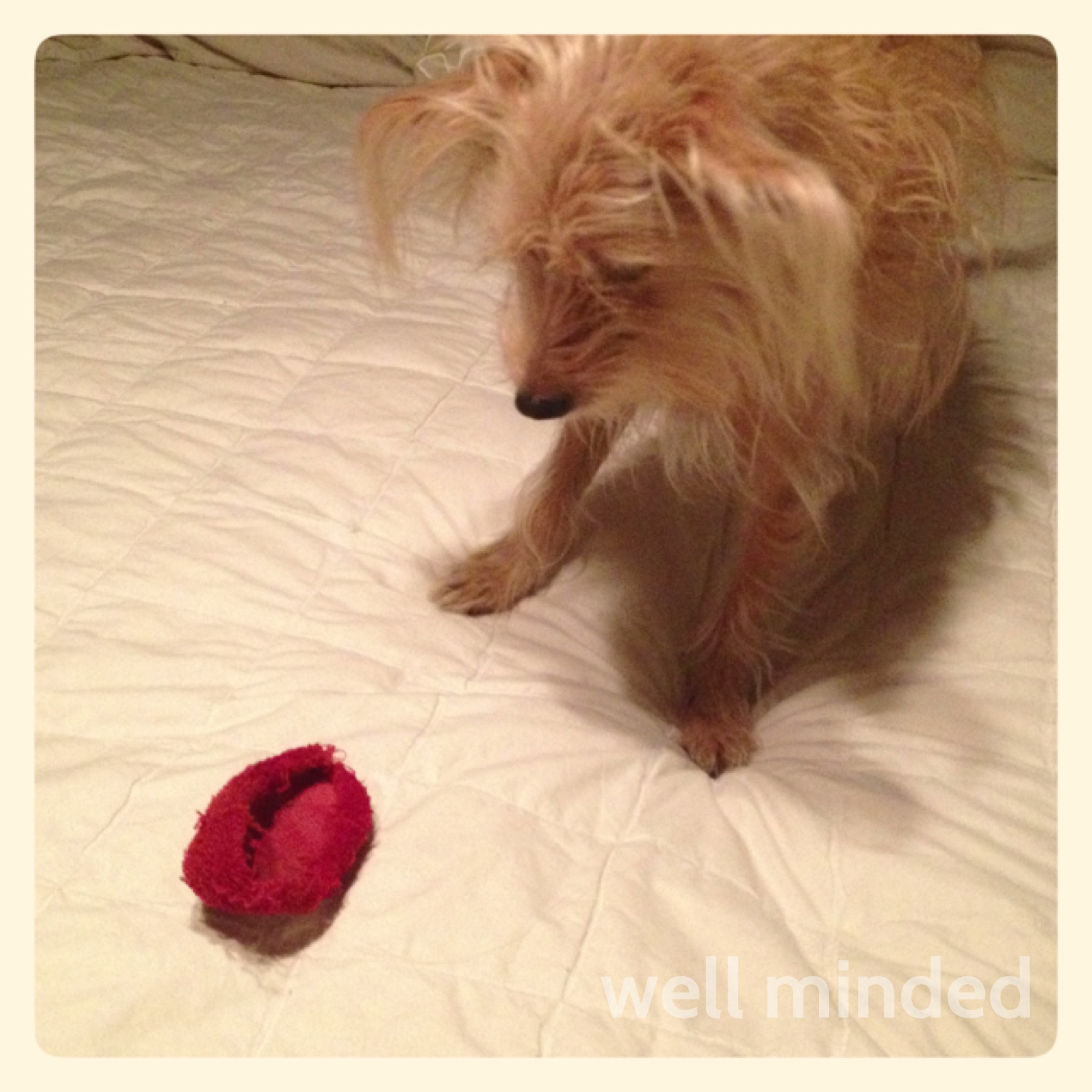 Our dog, N.A.S.H.A.'s most prized possession is a red sock toe. How do you get a sock toe, you ask? Well, you cut off the tip of a sock for your kid's school project, and the dog takes over the scraps. Said kid will now be a junior in high school come fall, and this sock toe was born when he was in third grade. It's much like a child's thread-bare blankie. If we ever lost it, the would would most certainly end.
Our dog, N.A.S.H.A.'s most prized possession is a red sock toe. How do you get a sock toe, you ask? Well, you cut off the tip of a sock for your kid's school project, and the dog takes over the scraps. Said kid will now be a junior in high school come fall, and this sock toe was born when he was in third grade. It's much like a child's thread-bare blankie. If we ever lost it, the would would most certainly end.
The sock toe is N.A.S.H.A.'s go-to toy. It's always the most played-with, so it keeps residence on top of all the other toys. She pulls it out when she wants to play, which, for a nearly eight-year-old dog, is pretty frequently. Sometimes she'll put it in our lap...it's just heavy enough to be thrown across the living room. She'll tear around the house with it in her mouth, drop it on purpose, high-tail it back to fetch it, then reverse her route. Most often, she'll toss it high in the air and catch it herself. Amusement for all.
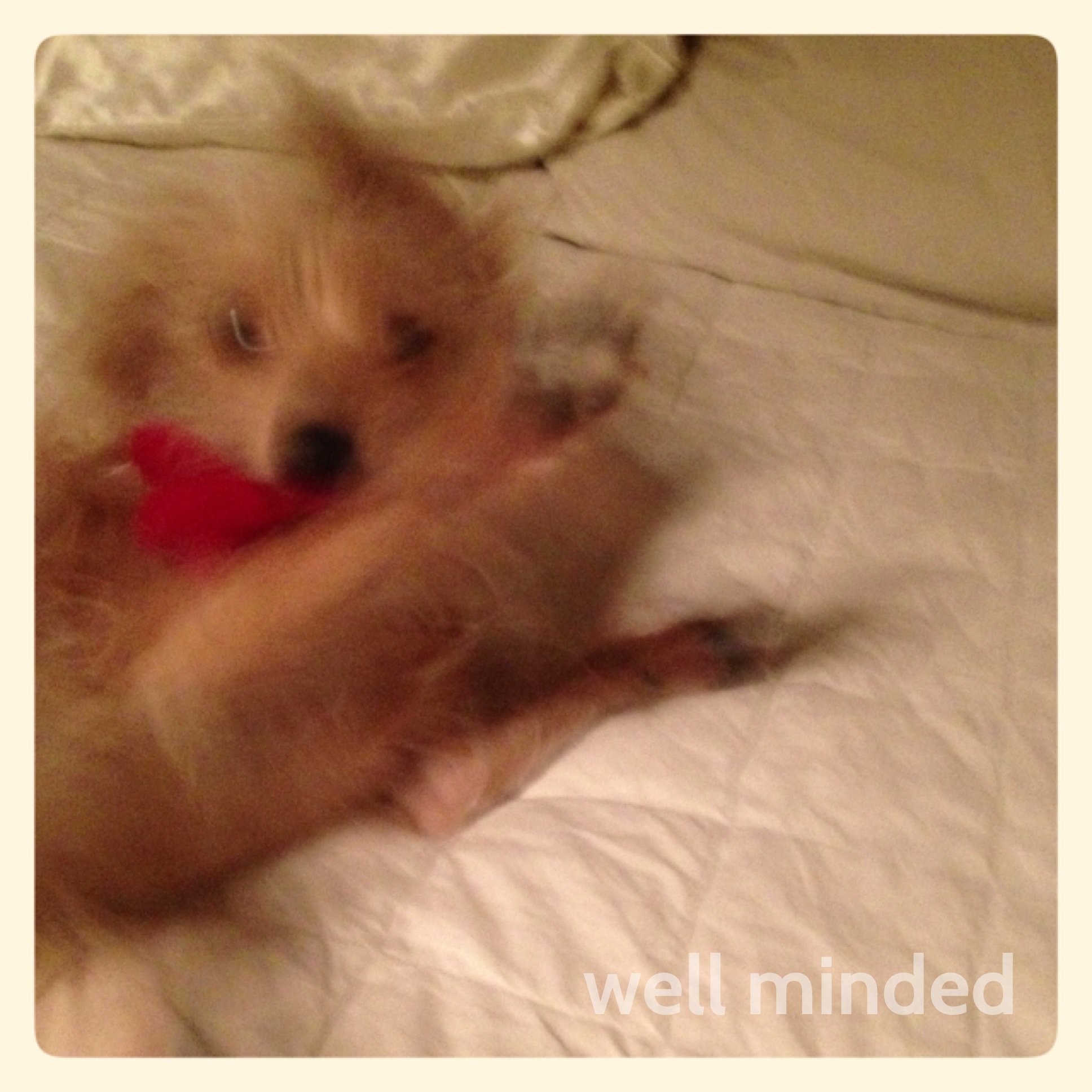 It makes it's way outside and back in. On the bed. Under the bed. In the closet. On the couch. But she can always find it. Maybe because it's never been washed. We don't want to risk it going to the dreaded sock place of the unknown underworld.
It makes it's way outside and back in. On the bed. Under the bed. In the closet. On the couch. But she can always find it. Maybe because it's never been washed. We don't want to risk it going to the dreaded sock place of the unknown underworld.
It has no squeaker, and no beefy flavor, and it does nothing beneficial to her teeth. I know it does a lot for her heart, though.



